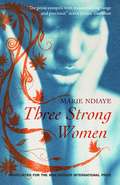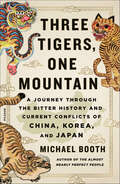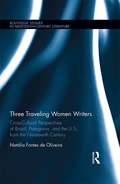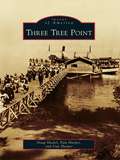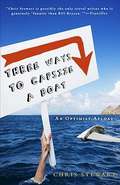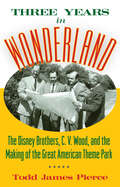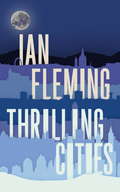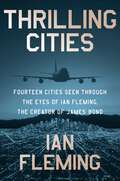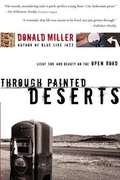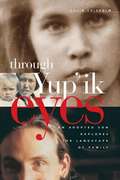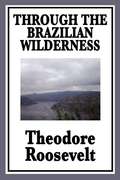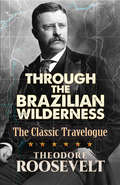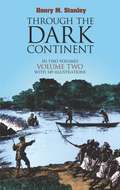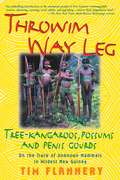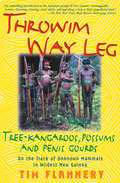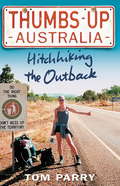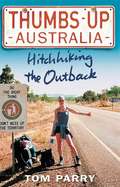- Table View
- List View
Three Strong Women
by Marie NDiayeForty-year-old Norah leaves Paris, her family and her career as a lawyer to visit her father in Dakar. It is an uncomfortable reunion - she is asked to use her skills as a lawyer to get her brother out of prison - and ultimately the trip endangers her marriage and her relationship with her own daughter, and drives her to the very edge of madness. Fanta, on the other hand, leaves Dakar to follow her husband Rudy to rural France. And it is through Rudy's bitter and guilt-ridden perspective that we see Fanta stagnate with boredom in this alien, narrow environment. Khady is forced into exile from Senegal because of poverty, because her husband is dead, because she is lonely and in despair. With other illegal immigrants, she embarks on a journey which takes her nowhere, but from which she will never return.
Three Tigers, One Mountain: A Journey Through the Bitter History and Current Conflicts of China, Korea, and Japan
by Michael BoothFrom the author of The Almost Nearly Perfect People, a lively tour through Japan, Korea, and China, exploring the intertwined cultures and often fraught history of these neighboring countries.There is an ancient Chinese proverb that states, “Two tigers cannot share the same mountain.” However, in East Asia, there are three tigers on that mountain: China, Japan, and Korea, and they have a long history of turmoil and tension with each other. In his latest entertaining and thought provoking narrative travelogue, Michael Booth sets out to discover how deep, really, is the enmity between these three “tiger” nations, and what prevents them from making peace. Currently China’s economic power continues to grow, Japan is becoming more militaristic, and Korea struggles to reconcile its westernized south with the dictatorial Communist north. Booth, long fascinated with the region, travels by car, ferry, train, and foot, experiencing the people and culture of these nations up close. No matter where he goes, the burden of history, and the memory of past atrocities, continues to overshadow present relationships. Ultimately, Booth seeks a way forward for these closely intertwined, neighboring nations.An enlightening, entertaining and sometimes sobering journey through China, Japan, and Korea, Three Tigers, One Mountain is an intimate and in-depth look at some of the world’s most powerful and important countries.
Three Traveling Women Writers: Cross-Cultural Perspectives of Brazil, Patagonia, and the U.S from the Nineteenth Century (Routledge Studies in Nineteenth Century Literature)
by Natália Fontes de OliveiraThis book presents an alternative framework for reading nineteenth century women’s travel narratives by challenging the traditional paradigms which often limit women’s space in print culture. For the first time, through a comparative lens, a Latin American woman’s travel narrative is analyzed concomitantly with the narratives of a North American and a European writer. Contrary to the common assumption that Latin American women were powerless victims of imperialism, elite women had access to the predominant philosophies of their time, traveled around the globe, and wrote about their experiences. This book examines how an Argentinian writer, together with an English and an American writer, manipulate their bourgeois identity to inhabit the male dominated sphere of print culture. By travelling and publishing travel narratives, the three traveling women writers search for empowerment to establish their authority as writers and shapers of knowledge in literature. Utilizing several concepts and criticisms, including Aristotle’s rhetoric, Foucault’s theories, travel writing criticism, postcolonial discourse, and feminist literary criticism; this volume attempts to challenge old-fashioned architypes and confinements of gender for traveling women writers in the nineteenth century.
Three Tree Point
by Doug Shadel Pam Harper Guy HarperThree Tree Point is a prominent peninsula on the eastern shore of Puget Sound about 14 miles south of Seattle. Its name came from three massive fir trees that stood on the north side of the point at the beginning of the 20th century. The area remained largely undeveloped until 1903 when the Three Tree Point Company began marketing the community as a place to build summer homes. Seattle's business elite built houses at the point to take advantage of the beach lifestyle for which it has become known. Over the years, Three Tree Point and its 2.5 miles of waterfront emerged as one of the Northwest's most unique residential communities. Its history is a diverse mixture of family life, unusual characters, Fourth of July celebrations, shipwrecks, fishing derbies, and storytelling.
Three Ways to Capsize a Boat: An Optimist Afloat
by Chris StewartChris Stewart had a long and eclectic list of jobs. From some of the most glamorous careers, such as being the original drummer in Genesis, to the more offbeat, a sheep shearer and circus performer, he had done it all . . . or almost all. So when he is offered the chance to captain a sailboat in the Greek Islands one summer, something he had never done, he jumps at the chance. Ever the optimist, Stewart is undaunted by the fact that he's never actually sailed before!
Three Years in Wonderland: The Disney Brothers, C. V. Wood, and the Making of the Great American Theme Park
by Todd James PierceWhile the success of Disneyland is largely credited to Walt and Roy Disney, there was a third, mostly forgotten dynamo instrumental to the development of the park—fast-talking Texan C. V. Wood. Three Years in Wonderland presents the never-before-told, full story of “the happiest place on earth.” Using information from over one hundred unpublished interviews, Todd James Pierce lays down the arc of Disneyland's development from an idea to a paragon of entertainment. In the early 1950s, the Disney brothers hired Wood and his team to develop a feasibility study for an amusement park that Walt wanted to build in southern California. “Woody” quickly became a central figure. In 1954, Roy hired him as Disneyland's first official employee, its first general manager, and appointed him vice president of Disneyland, Inc., where Walt’s authority only exceeded Wood’s authority. A brilliant project manager, Wood was also a con artist of sorts. Previously, he had forged his university diploma. A smooth-talker drawn to Hollywood, the first general manager of Disneyland valued money over art. As relations soured between Wood and the Disney brothers, Wood found creative ways to increase his income, leveraging his position for personal fame. Eventually, tensions at the Disney park reached a boiling point, with Walt demanding Wood be fired. In compelling detail, Three Years in Wonderland lays out the struggles and rewards of building the world's first cinematic theme park and convincing the American public that a $17 million amusement park was the ideal place for a family vacation. The early experience of Walt Disney, Roy Disney, and C. V. Wood is one of the most captivating untold stories in the history of Hollywood. Pierce interviewed dozens of individuals who enjoyed long careers at the Walt Disney Company as well as dozens of individuals who—like C. V. Wood—helped develop the park but then left the company for good once the park opened. Through much research and many interviews, Three Years in Wonderland offers readers a rare opportunity to stand shoulder-to-shoulder with the people who built the best-known theme park in the world.
Thrilling Cities
by Ian FlemingThe author of the phenomenally successful James Bond series takes you on a tour of some of the most amazing cities in the world, including Honolulu, Chicago, New York, Los Angeles, Las Vegas, Hamburg, Hong Kong, Macau, Geneva, Tokyo, Berlin, Vienna, Naples and Monte Carlo. The book is based on a series of newspaper articles written by Fleming, and describes the cities with the same mix of a novelists imagination and an intelligence operative's keen eye that made the 007 stories so gripping. Penguin Random House Canada is proud to bring you classic works of literature in ebook form, with the highest quality production values. Find more today and rediscover books you never knew you loved.
Thrilling Cities: Fourteen Cities Seen Through the Eyes of Ian Fleming, the Creator of James Bond
by Ian FlemingA CAPTIVATING JOURNEY AROUND THE WORLD FROM THE CREATOR OF JAMES BONDIan Fleming’s world travels and interests, as well as his journalism and wartime experiences, lent authority to everything he wrote. In 1959, the Sunday Times commissioned Fleming to write a series of dispatches from the world’s most beguiling locales. The result was Thrilling Cities, a masterpiece of well-observed travelogue that stands ably alongside the author’s Bond canon.From Hong Kong to Honolulu, New York to Naples, he left the bright main streets for the back alleys, abandoning tourist sites in favor of underground haunts, and mingling with celebrities, gangsters and geishas. The result is a series of vivid snapshots of a mysterious, vanished world from a twentieth century Western perspective.Just like his most famous fictional creation, Ian Fleming was a well-traveled man of the world who knew where to go to find excitement, adventure…and danger. In Thrilling Cities, he takes us along on a journey of international intrigue worthy of James Bond.
Through Painted Deserts
by Donald MillerBelieving that something better exists than the mundane life, this is a memoir of two free spirits who set off on an adventure-filled road trip in search of deeper meaning, beauty, and an explanation for life. Many young men dream of such a trip, but few are brave enough to actually attempt it. Miller records the trip with wide-eyed honesty in achingly beautiful prose also discussing everything from the nature of friendship, the reason for pain, and the origins of beauty.
Through Siberia by Train: Adventuring on the Great Trans-Siberian Express
by Jules G. ZonnInformation about modern train travel in Siberia is not easily available from any source. Jules Zonn has compiled facts and given the details about train travel in Siberia.
Through Yup'ik Eyes: An Adopted Son Explores the Landscape of Family
by Colin ChisholmThe author, adopted as an infant by a Caucasian father and half-Eskimo mother, makes a series of trips to Alaska after his adoptive mother's death. There he connects with her Eskimo relatives, from whom she was separated at the age of six. Chisholm reconstructs the history of his adoptive mother's family in a series of fictional sketches based on stories he was told by the surviving members. This reconstruction gives him a new perspective on his mother's life and his own.
Through the Brazilian Wilderness
by Theodore RooseveltAfter losing his bid for the United States Presidency as a third party candidate, Theodore Roosevelt decided to take on the most dangerous adventure left on earth. He and his son, Kermit, accepted Candido Mariano da Silva Rondon's invitation to help him plot the course of the River of Doubt. The River of Doubt could just as easily have been named the River of Death. The river's rapids turned out to be much more ferocious than expected, cannibalistic natives dogged the group through most of the journey, and Murphy was their constant companion. The expedition lost men, supplies, and canoes. At one point, Roosevelt contracted a flesh-eating bacteria and became so weak that he urged his son to leave him behind to die. Ultimately Teddy and Kermit emerged from the wilderness triumphantly. Here is their story in Theodore Roosevelt's own words.
Through the Brazilian Wilderness: The Classic Travelogue
by Theodore Roosevelt"Roosevelt has been able to add one more excellent volume to a list which is already a praiseworthy record." — The New York Times"An exceedingly fascinating story of adventure. It is the best story ... that the many-sided former president of the United States has produced." — The Boston TranscriptHere is the tale of the famed conservationist and outdoorsman's last great adventure, recounted in his own words. In a narrative that crackles with energy and enthusiasm, Theodore Roosevelt tells of the challenges and perils he and his companions faced during a 1913–14 expedition to a remote area of the Brazilian Amazon basin. Roosevelt, his son Kermit, and their crew set out to chart the nearly 1,000-mile long "River of Doubt," in addition to collecting thousands of plant and animal specimens.Written with the expertise and zest of a seasoned naturalist, Roosevelt's account combines the thrill of scientific exploration with the suspense of harrowing dangers. Stalked by cannibals and menaced by wild animals, the crew was in constant jeopardy of drowning in the turbulent rapids. Overwhelming heat, food shortages, and a plague of insects hampered their progress, in addition to Roosevelt's affliction with a life-threatening tropical fever. This real-life drama of courage and discovery will captivate historians and Roosevelt fans as well as modern-day explorers and lovers of adventure.
Through the Dark Continent: Vol. 2
by Henry M. StanleyPerhaps best known as the intrepid adventurer who located the missing explorer David Livingstone in equatorial Africa in 1871, Henry Morton Stanley (1841-1904) played a major role in assembling the fragmented discoveries and uncertain geographical knowledge of central Africa into a coherent picture. He was the first European to explore the Congo River; assisted at the founding of the Congo Free State, and helped pave the way for the opening up of modern Africa.In this classic account of one of his most important expeditions, the venerable Victorian recounts the incredibly difficult and perilous journey during which he explored the great lakes of Central Africa, confirming their size and position, searched for the sources of the Nile, and traced the unknown Congo River from the depths of the continent to the sea. Accompanied by three Englishmen and a crew of Africans, Stanley left Zanzibar in 1874. He traveled to Lake Victoria, which he circumnavigated in his boat, the Lady Alice. Almost immediately, illness, malnutrition and conflicts with native tribes began to decimate his followers. Nevertheless, the explorer pushed on, also circumnavigating Lake Tanganyika, which he determined to be unconnected with the Nile system. Finally in 1876, Stanley was ready to undertake "the grandest task of all" — exploring the Livingstone (Congo) River. He sailed down the vast waterway to the lake he called Stanley Pool, then on to a series of 32 cataracts he named Livingstone Falls. Unable to go further by boat, Stanley continued overland, reaching the Atlantic Ocean on August 12, 1877. Mishaps, hostile tribes, and disease had killed his three white companions and half the Africans, but Stanley had attained his objective.His tremendous perseverance (his persistence led his men to nickname him Bula Matari — "the rock breaker") was complemented by Stanley's abilities as a keen observer and accomplished prose stylist. These talents are fully evident in this exciting narrative. It offers not only the action and adventure of a life-and-death struggle to survive in the African wilderness, but detailed descriptions of native peoples, customs, and culture; the flora and fauna of central Africa; and a wealth of geographical, ecological, and other information. Supplemented with 149 black-and-white illustrations and a foldout map, this monumental narrative will be welcomed by anyone interested in the European exploration of central Africa during the nineteenth century, the exploits of one of the great explorers of all time, and a breathtaking story of human endurance and achievement in the face of immense odds.
Throwim Way Leg: On the Track of Unknown Mammals in Wildest New Guinea
by Tim FlanneryIn New Guinea pidgin, "Throwim Way Leg" means to kick out your leg on the first step of a long journey. Full of adventure, wit, and natural wonders, Flannery's narrative is just such a spectacular trip -- a tour de force of travel, anthropology, and natural history.
Throwim Way Leg: Tree-Kangaroos, Possums, and Penis Gourds: On the Track of Unknown Mammals in Wildest New Guinea
by Tim FlanneryTim Flannery is a scientist of international standing, a world expert on the fauna of New Guinea with twenty new species and seven books to his credit. In Throwim Way Leg, he takes us into the field and on an unforgettable journey into the heart of this mysterious and uncharted country. The result is a book of wonder and excitement, brimming with marvelous stories.Flannery’s scientific voyage leads him to places he never dreamed of: he camps among cannibals and befriends Femsep, a legendary warrior who led the slaughter of colonial whites decades before. He enters caves full of skeletons of long-extinct, giant marsupials, scales mountains previously untouched by Europeans, and is nearly killed when tribes people decide to take revenge for their prior mistreatment by his "clan” (wildlife scientists). And Flannery writes movingly of the fate of indigenous people in collision with the high-tech world of late-twentieth-century industry.In New Guinea pidgin, throwim way leg means to thrust out your leg on the first step of a long journey. Full of adventure, wit, and natural wonders, Flannery’s narrative is just such a spectacular trip. Like Redmond O’Hanlon’s classics Into the Heart of Borneo and No Mercy, Throwim Way Leg is a tour de force of travel, anthropology, and natural history.
Thumbs Up Australia
by Tom ParryWith anecdotes and endearing tales of characters met along the way, Thumbs Up Australia follows the exploits of an English hitchhiker and his reluctant French girlfriend as the two uncover a never-before-seen Australia. Tom Parry carries the reader through almost-empty highways and a distinctively Aussie society on a journey of 8,000 miles-with just as many adventures.
Thumbs Up Australia: Hitchhiking the Outback
by Tom ParryOn the Road meets Down Under in this really rough guide to the adventures of an enthusiastic hitchhiker and his reluctant girlfriend on their quest for the real Australia. Hitching lifts with the desert's dodgiest drivers and taking breaks in the roughest roadhouses, this is Tom Parry's witty, warts-and-all tale of hitchhiking 8,000 miles across - and around - the Australian outback with his thumb, his backpack and his French girlfriend, Katia. As the couple hitch their way around the near empty highways, they encounter as wide a cross-section of Aussie society as you could ever hope to meet. In cattle stations, Aboriginal communities, remote waterholes, caravan parks, hippy communes and roadhouses, they see a country that remains as extraordinary today as it was for the first nineteenth century settlers. Loosely following the routes carved out by the legendary explorers who first traversed the great continent, the couple get to grips with the country's fascinating history. Set against a backdrop of the real Australia - not 'as seen on TV'- "Thumbs Up Australia" is full of wonderful anecdotes and endearing tales of some of the country's most idiosyncratic characters, from the grizzled Aboriginal elder with his tales of dreamtime, to an amphetamine-swallowing road train driver. And at the end of their journey, it is ironically Katia who suggests thumbing a lift to the airport!
Thumbs Up Australia: Hitchhiking the Outback
by Tom ParryOn the Road meets Down Under in this really rough guide to the adventures of an enthusiastic hitchhiker and his reluctant girlfriend on their quest for the real Australia. Hitching lifts with the desert's dodgiest drivers and taking breaks in the roughest roadhouses, this is Tom Parry's witty, warts-and-all tale of hitchhiking 8,000 miles across - and around - the Australian outback with his thumb, his backpack and his French girlfriend, Katia. As the couple hitch their way around the near empty highways, they encounter as wide a cross-section of Aussie society as you could ever hope to meet. In cattle stations, Aboriginal communities, remote waterholes, caravan parks, hippy communes and roadhouses, they see a country that remains as extraordinary today as it was for the first nineteenth century settlers. Loosely following the routes carved out by the legendary explorers who first traversed the great continent, the couple get to grips with the country's fascinating history. Set against a backdrop of the real Australia - not 'as seen on TV'- "Thumbs Up Australia" is full of wonderful anecdotes and endearing tales of some of the country's most idiosyncratic characters, from the grizzled Aboriginal elder with his tales of dreamtime, to an amphetamine-swallowing road train driver. And at the end of their journey, it is ironically Katia who suggests thumbing a lift to the airport!
Thursday Night Widows
by Miranda France Claudia Piñeiro"An agile novel written in a language perfectly pitched for the subject matter, a ruthless dissection of a fast decaying society"--José Saramago, Nobel Prize winnerThe English translation of hit novel Las Viudas de Los Jueves!"Piñeiro's clever U.S. debut.. . illuminates the hypocrisies of the country's upper classes after 9/11."--Publishers Weekly"Piñeiro is particularly skilful at exposing the social forces undermining Argentine society, and the fragility of personal relationships. We learn the surprising truth of the three men's death in the final chapter; the build-up to it is riveting."--The Times (London)"Piñeiro builds up tension through banal, domestic details and the accretion of despair in everyday marital and professional struggles. There may be bloody murder at the centre of this novel, but the dystopia portrayed is an indictment not solely of an assassin but of Argentina's class structure and the willful blindness of its petty bourgeoisie."--Times Literary Supplement"A razor-sharp psychological and social portrait not only of Argentina, but of the afluent Western world as a whole."--Rosa MonteroThree bodies lie at the bottom of a swimming pool in a gated country estate near Buenos Aires. It's Thursday night at the magnificent Scaglia house. Behind the locked gates, shielded from the crime, poverty, and filth of the people on the streets, the Scaglias and their friends hide lives of infidelity, alcoholism, and abusive marriage. Claudia Piñeiro's novel eerily foreshadowed a criminal case that generated a scandal in the Argentine media. But this is more than a story about crime. The suspense is a byproduct of Piñeiro's hand at crafting a psychological portrait of a professional class that lives beyond its means and leads secret lives of deadly stress and despair. It takes place during the post-9/11 economic meltdown in Argentina, but it is a universal story that will resonate among credit-crunched readers of today.The film of Thursday Night Widows, by Argentine New Wave and award-winning director Marcelo Piñeyro is coming soon with trailers available online.Claudia Piñeiro was a journalist, playwright, and television scriptwriter and in 1992 won the prestigious Pléyade Annual Journalism Award. She has more recently turned to fiction and is the author of literary crime novels that are all bestsellers in Latin America and have been translated into four languages. This novel won the Clarin Prize for fiction and is her first title to be available in English.
Tibet, Tibet
by Patrick FrenchAt different times in its history Tibet has been renowned for pacifism and martial prowess, enlightenment and cruelty. The Dalai Lama may be the only religious leader who can inspire the devotion of agnostics. Patrick French has been fascinated by Tibet since he was a teenager. He has read its history, agitated for its freedom, and risked arrest to travel through its remote interior. His love and knowledge inform every page of this learned, literate, and impassioned book.Talking with nomads and Buddhist nuns, exiles and collaborators, French portrays a nation demoralized by a half-century of Chinese occupation and forced to depend on the patronage of Western dilettantes. He demolishes many of the myths accruing to Tibet-including those centering around the radiant figure of the Dalai Lama. Combining the best of history, travel writing, and memoir, Tibet, Tibet is a work of extraordinary power and insight.From the Trade Paperback edition.
Tibetan Rescue
by Pamela LoganThe culture and artifacts of Tibet,like those of other remote indigenoussocieties, are under siege by the relentless modern world. The fate of monasteries in Tibet has been a subject of concern to many in the West; butuntil Tibetan Rescue little specific information had been published. As president of a nongovernmental organization that brings foreign aid intoTibet, Pamela Logan brings a first-hand account of h er journey through Tibet,as she evolves from solo traveler to expedition leader. Her mission: to savethe precious ancient murals of Pewar Monastery. To reach her goal she travels a long and circuitous path raising funds, getting permission from the Chinese bureaucracy, assembling an international team, and leading fourexpeditions by bus, truck, and horse caravan to Pewar Monastery. Along theway she meets a memorable parade of characters, overcomes bureaucrats andblizzards, and survives a brutal attack by a pack of Tibetan dogs. Her book is an insider's look at a remote and little known part of Tibet, her story an inspiration to those who cherish challenge and adventure.
Tibetan Rescue
by Pamela LoganThe culture and artifacts of Tibet,like those of other remote indigenoussocieties, are under siege by the relentless modern world. The fate of monasteries in Tibet has been a subject of concern to many in the West; butuntil Tibetan Rescue little specific information had been published. As president of a nongovernmental organization that brings foreign aid intoTibet, Pamela Logan brings a first-hand account of h er journey through Tibet,as she evolves from solo traveler to expedition leader. Her mission: to savethe precious ancient murals of Pewar Monastery. To reach her goal she travels a long and circuitous path raising funds, getting permission from the Chinese bureaucracy, assembling an international team, and leading fourexpeditions by bus, truck, and horse caravan to Pewar Monastery. Along theway she meets a memorable parade of characters, overcomes bureaucrats andblizzards, and survives a brutal attack by a pack of Tibetan dogs. Her book is an insider's look at a remote and little known part of Tibet, her story an inspiration to those who cherish challenge and adventure.
Tibetan Rescue
by Pamela LoganThe culture and artifacts of Tibet, like those of other remote indigenous societies, are under siege by the relentless modern world. The fate of monasteries in Tibet has been a subject of concern to many in the West; but until Tibetan Rescue little specific information had been published. As president of a non-governmental organization that brings foreign aid into Tibet, Pamela Logan brings a first-hand account of her journey through Tibet.Pamela evolves from solo traveler to expedition leader on her mission: to save the precious ancient murals of Pewar Monastery. To reach her goal she travels a long and circuitous path raising funds, getting permission from the Chinese bureaucracy, assembling an international team, and leading four expeditions by bus, truck, and horse caravan to Pewar Monastery. Along the way she meets a memorable parade of characters, overcomes bureaucrats and blizzards, and survives a brutal attack by a pack of Tibetan dogs. Her book is an insider's look at a remote and little known part of Tibet, her story an inspiration to those who cherish challenge and adventure.
Tiburon and Belvedere
by Branwell FanningTiburon and Belvedere share the same spectacular peninsula jutting into San Francisco Bay from Marin County, California. With water on three sides, fabulous views everywhere, and San Francisco a 30-minute ferry ride away, these two communities have become highly desirable places to live. Historian Branwell Fanning, twice mayor of Tiburon, using his own collection and the archives of the Belvedere/Tiburon Landmarks Society, describes the area's transition from dairy ranches, railroad yards, military bases, and cod fisheries, to charming villages filled with homeowners.
